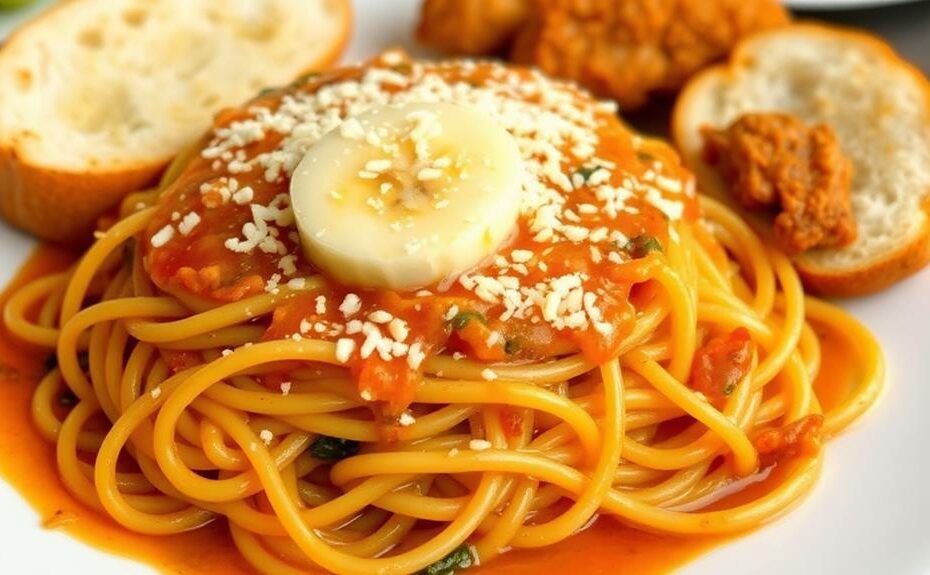Filipino-style spaghetti is distinct from its Italian counterpart due to its unique blend of sweet and savory flavors. This fusion is achieved through the use of ingredients like banana ketchup, hot dogs, and condensed milk, which may seem unconventional to those familiar with traditional spaghetti.
Banana ketchup, a sweet and tangy condiment, replaces traditional tomato sauce, adding a fruity twist to the dish. The addition of hot dogs, a common ingredient in Filipino cuisine, provides a savory element, while condensed milk adds a rich and creamy texture.
These ingredients reflect the cultural and historical influences of the Philippines, resulting in a flavor profile that is both familiar and innovative.
Origins of Filipino Spaghetti

Filipino Spaghetti Originated During the American Commonwealth Period
During the American Commonwealth Period, Filipino cuisine underwent a significant transformation due to the introduction of new ingredients and cooking techniques by American colonizers.
This period marked the beginning of Filipino spaghetti.
American Influence Led to a Fusion of Flavors
The introduction of spaghetti by American colonizers sparked a creative fusion of flavors and ingredients.
When World War II broke out, a tomato shortage led to the innovative creation of banana ketchup, a sweet and tangy condiment that would become a defining characteristic of Filipino spaghetti.
Hot Dogs Became a Staple Ingredient
Filipino spaghetti often features hot dogs, a nod to American influence.
This unique combination of ingredients was first popularized in an orphanage in Cebu, where cooks adapted the traditional Italian bolognese to suit local tastes for sweetness.
Evolution into a Comfort Food
Over time, Filipino spaghetti evolved into a comfort food, commonly served at children's birthday parties and family gatherings.
Today, it's a symbol of cultural heritage and nostalgia among Filipinos, reflecting the country's culinary innovation and adaptability.
Unique Flavor Profile
Filipino-style spaghetti has a distinct flavor profile that sets it apart from traditional Italian spaghetti.
This unique flavor profile is achieved through the combination of ingredients like ground pork, sliced hot dogs, and luncheon meat, which add sweet and savory notes to the dish.
The tomato sauce is sweetened with brown sugar or condensed milk, giving it a fruity flavor that differs from traditional Italian sauces.
The addition of red hot dogs not only adds to the sweetness but also creates a visually appealing dish, aligning with Filipino cultural perceptions of deliciousness.
The richness of the dish is further enhanced by the grated quick-melting cheese, usually cheddar, which adds creaminess and indulgence to the flavor profile.
The sweetness of the sauce balances out the saltiness of the meat, creating a harmonious blend of flavors that appeals to children and families.
The unique flavor profile of Filipino-style spaghetti is a result of the careful balance of sweet, savory, and rich elements, making it a distinct and delicious twist on the traditional Italian dish.
Sweet and Savory Elements
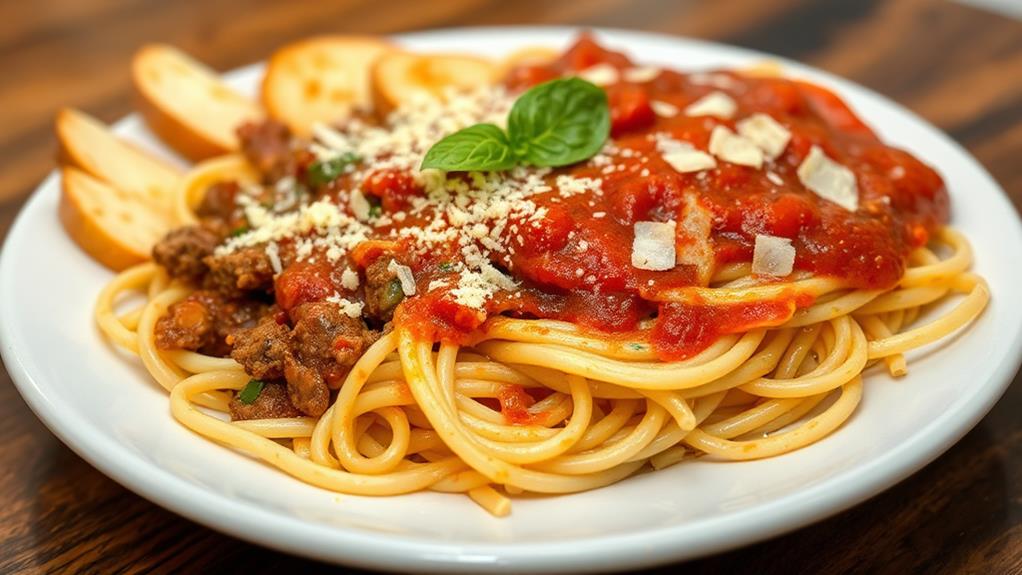
Filipino-style spaghetti recipes strike a balance between sweet and savory flavors. This unique flavor profile is achieved by combining ground meat and red hotdogs in the sauce, which adds a sweet and tangy flavor.
The sweetness is further enhanced by adding sugar, banana ketchup, or condensed milk, catering to the Filipino palate's preference for sweeter flavors.
The use of red hotdogs adds a pop of color and flavor. These sweeter hotdogs balance out the savory flavors of the ground meat, creating a harmonious blend of flavors.
To complete the dish, grated cheese is often sprinkled on top, adding a creamy texture that complements the sweet and savory elements. This results in a sweet spaghetti that's both comforting and flavorful, making it a staple in Filipino food culture.
Cultural Significance Explained
Filipino-style spaghetti holds a special place in the country's culinary culture. This significance is rooted in nostalgia and warmth, as many Filipinos recall enjoying it at kids' birthday parties alongside fried chicken and cake.
This dish reflects the cultural significance of family-oriented dining in the Philippines, where mealtimes are a celebration of togetherness.
The vibrant red color of the spaghetti is culturally associated with deliciousness. This is due to the use of banana ketchup and red hot dogs, which add to the festive atmosphere.
Even fast-food chains like Jollibee have adopted their own version of Filipino spaghetti, cementing its status as a beloved dish in Filipino cuisine and culture.
Authentic Filipino spaghetti is more than just a meal. It's a symbol of warmth, togetherness, and celebration, representing the blending of Filipino traditions with foreign influences.
This blending is a testament to the evolution of culinary practices in the Philippines.
Preparation Techniques Uncovered
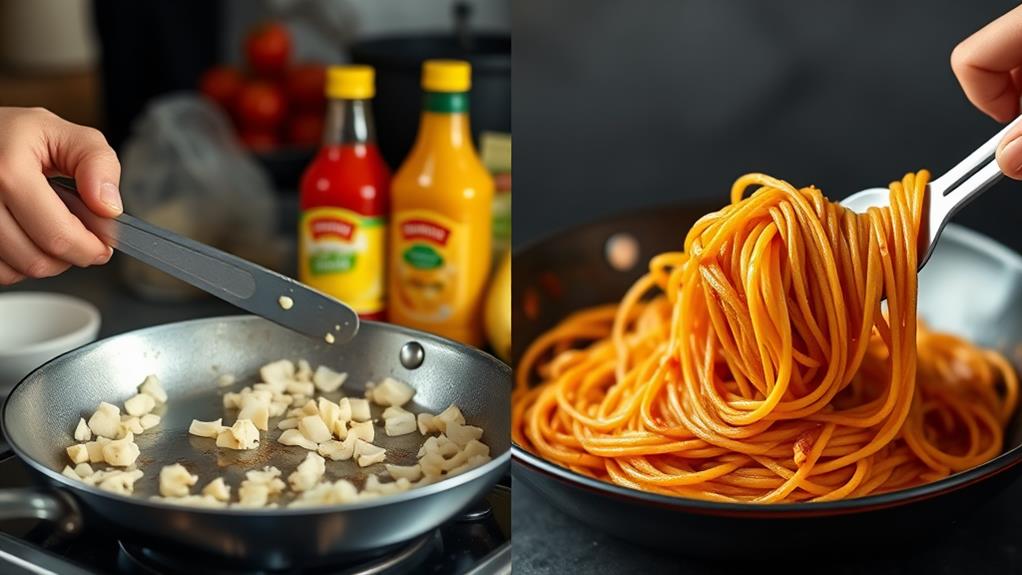
A harmonious balance of sweet, tangy, and savory flavors is the foundation of a memorable Filipino spaghetti dish.
To achieve this balance, start by sautéing garlic and onions until caramelized, which forms the flavorful base of the sauce.
Brown ground meat, typically pork or beef, before adding banana ketchup and tomato sauce for the signature sweet and tangy flavor profile.
Optional ingredients like sliced hot dogs, luncheon meat, or Spam can be incorporated to enhance the dish's richness and protein content.
To reach the desired consistency, adjust the sauce by adding evaporated milk or sugar to balance acidity and increase creaminess.
Regional Variations and Twists
Regional variations add a new layer of excitement to Filipino spaghetti, bringing unique flavor profiles to the table.
In Nueva Ecija, bangus spaghetti is a staple, substituting traditional meat with local milkfish for a distinct flavor and texture.
Additional vegetables like bell peppers and carrots are incorporated in other regions, boosting the nutritional value and adding a pop of color.
Alternative seasonings like fish sauce or bouillon cubes deepen the flavor profile of the sauce.
Filipino spaghetti is often adapted to include local ingredients or regional delicacies, making each version a reflection of its locality's culinary heritage.
Fast food chains like Jollibee put their own spin on the dish, adding sliced hot dogs and a hint of sweetness to cater to local tastes.
Common Ingredients and Substitutes
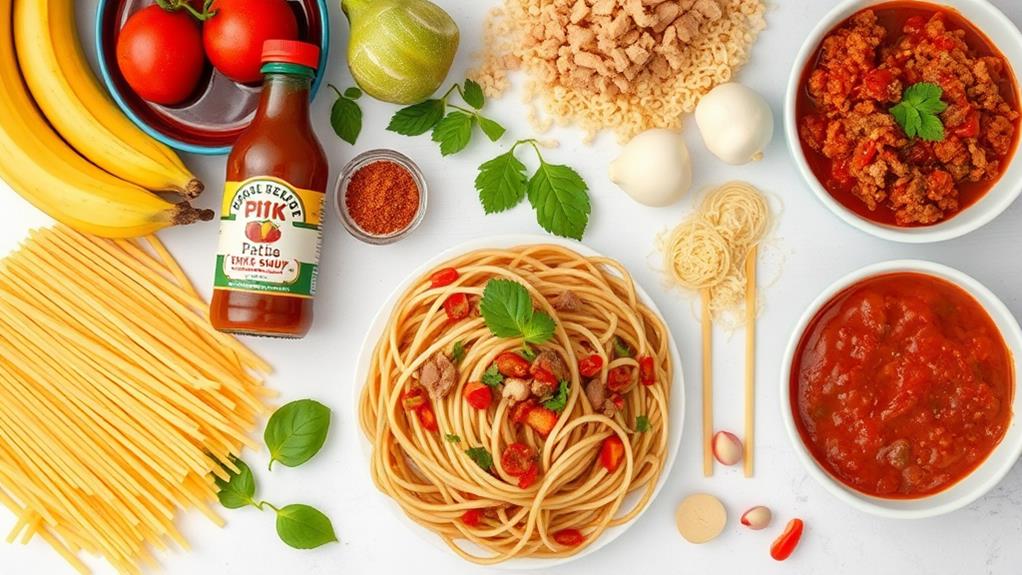
Creating the Perfect Filipino-Style Spaghetti Sauce
Essential Ingredients:
To craft a traditional Filipino-style spaghetti, you'll need the following essential ingredients:
Ground Pork: adds a meaty flavor and texture to the sauce.
Sliced Red Hot Dogs: provide a surprising pop of flavor and color.
Grated Cheese: such as quick-melting cheese, adds richness as a popular topping.
Evaporated Milk: helps balance the acidity and sweetness of the tomato sauce, creating a creamy and indulgent flavor profile.
Substitutions and Variations:
When experimenting with alternatives, consider the following:
Potted Meat or Luncheon Meat: can be used to cater to different dietary preferences.
Store-Bought Filipino-Style Spaghetti Sauce: is a convenient option, with some variations incorporating Beef Broth or Mushroom Soup for added depth.
Cooking Tips and Tricks
Mastering Filipino-Style Spaghetti: Techniques for Success
Step 1: Cooking Perfect Noodles
When cooking spaghetti noodles, salt the water generously to prevent blandness and enhance the overall flavor of the dish.
Step 2: Preparing the Sauce
Use store-bought Filipino-style spaghetti sauce for convenience. To balance the acidity, add a touch of sugar to achieve a sweeter flavor profile typical in Filipino spaghetti.
Add ground pork to the sauce and simmer until it's fully cooked.
Step 3: Achieving the Right Consistency
Add evaporated milk to the sauce to add creaminess and balance the sweetness.
For a thicker sauce, simmer the meat mixture longer and use reserved pasta water to adjust the sauce consistency as needed before mixing with the noodles.
Step 4: Final Touches
Top your finished dish with quick-melting cheese such as Velveeta or cheddar, allowing it to melt into the warm sauce.
What specific ingredients or flavors make Filipino style spaghetti unique?
Filipino style spaghetti stands out due to its sweet and tangy sauce, which sets it apart from its Italian counterpart. The use of banana ketchup and hotdog slices arepkey differences between spaghetti, giving Filipino spaghetti its distinct flavor profile that locals and foreigners alike have come to love.
Evolution of Filipino Spaghetti
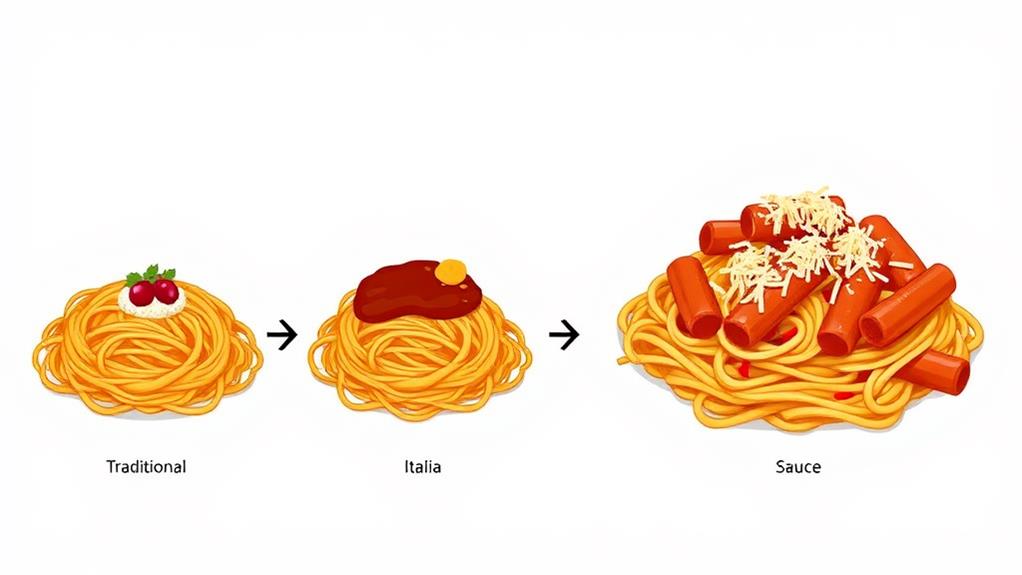
Filipino spaghetti has a unique evolution shaped by the country's cultural and historical context. Introduced during the American colonial period, Filipino cooks adapted American spaghetti recipes to local tastes and available ingredients, creating a distinct flavor profile.
The use of banana ketchup was a key factor in its evolution. During WWII, tomato shortages led to the use of banana ketchup, which added a sweet and tangy flavor to the dish.
Filipino spaghetti incorporates sweet elements. Unlike traditional Italian spaghetti, Filipino spaghetti includes brown sugar, making it sweeter and more appealing to local tastes.
Red hot dogs are a staple in Filipino spaghetti. The addition of red hot dogs provides a unique flavor and color to the dish, setting it apart from other versions of spaghetti.
The blending of sauces is a hallmark of Filipino spaghetti. A rich, sweet, and slightly tangy sauce is created by combining tomato sauce and meat, catering to the Filipino palate, especially for children.
Today, Filipino spaghetti is a popular comfort food. Often served at birthday parties and family gatherings, its evolution is a testament to the country's cultural adaptability and creativity in the culinary sphere.
Frequently Asked Questions
How Is Filipino Spaghetti Different?
Filipino spaghetti differs from traditional Italian spaghetti in its ingredients and cooking techniques.
The ingredients used in Filipino spaghetti are tweaked to incorporate sweet and tangy flavors. For instance, banana ketchup and added sugar are used to give the dish a unique taste. This fusion of flavors is a distinct characteristic of Filipino spaghetti.
The cooking techniques used in Filipino spaghetti also differ from traditional Italian recipes. Thick, creamy sauces made with evaporated milk are a hallmark of Filipino spaghetti. This creamy sauce is a result of the addition of evaporated milk, which isn't typically used in traditional Italian spaghetti recipes.
Filipino spaghetti is often served at family gatherings and festive occasions, reflecting the local taste preferences.
This cultural fusion dish has become an integral part of Filipino cuisine and is often showcased at special events.
Why Is Filipino Spaghetti Sauce Sweet?
Filipino spaghetti sauce is sweet because of the addition of banana ketchup. This local ingredient was developed during WWII and contributes a sweet flavor to the sauce.
The sweetness is balanced with savory flavors to create a unique taste experience.
Cultural influences and a preference for sweet flavors in Filipino cuisine also contribute to the distinctiveness of the sauce.
In the Philippines, sweet flavors are often associated with festive occasions and family gatherings. As a result, the sweet and savory flavors of the spaghetti sauce are well-suited for these types of events.
What Makes Filipino Dish Unique?
Cultural influences shape a dish's uniqueness. The blending of different cultural traditions, such as Spanish, Chinese, and American, has resulted in a distinct Filipino cuisine. For example, adobo, a popular Filipino dish, combines Spanish vinegar and soy sauce, which is a Chinese influence.
Regional variations add diversity. Filipino dishes vary depending on the region, with each area using local ingredients and cooking techniques. In the northern region of Ilocos, for instance, dishes are known for their bold flavors and use of vegetables, while in the southern region of Mindanao, dishes are often spicy and feature coconut milk.
Ingredient substitutions create surprises. Filipino cuisine is known for its creative use of ingredients, such as using ube (purple yam) instead of traditional sweet potatoes in desserts. This substitution adds a unique flavor and color to the dish.
Family traditions and festival favorites contribute to a dish's identity. Filipino dishes are often tied to family traditions and celebrations, such as the lechon (roasted pig) served during fiestas and special occasions. These dishes are passed down through generations, maintaining their cultural significance.
Specialized cooking techniques enhance the culinary experience. Filipino cooking techniques, such as grilling and braising, are used to bring out the flavors of ingredients.
For example, inihaw na liempo (grilled pork belly) is a popular dish that showcases the skill of Filipino cooks in grilling meat to perfection.
Why Is Spaghetti so Popular in the Philippines?
Filipino culture's openness to foreign influences has made spaghetti a staple in the Philippines.
This cultural adaptability has led to spaghetti becoming an integral part of family gatherings and festive occasions in the country.
In the Philippines, spaghetti is more than just a meal; it's a symbol of togetherness.
The dish has undergone a unique fusion of Italian and local flavors, resulting in street food and regional variations that reflect the country's culinary identity.
For instance, Filipinos often add a sweet twist to their spaghetti by using banana ketchup or mixing it with other local ingredients.
This blend of cultures has solidified spaghetti's place in Philippine food history, making it a comfort food that brings people together.
In the Philippines, spaghetti isn't just a foreign dish; it's a part of the local culinary heritage.
